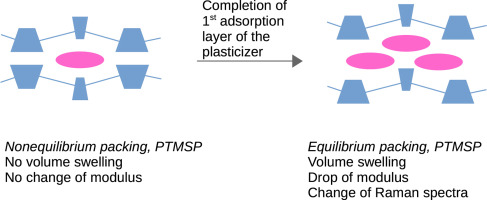Polymer ( IF 4.1 ) Pub Date : 2019-12-30 , DOI: 10.1016/j.polymer.2019.122140 Tereza-Markéta Durďáková , Zdeněk Hrdlička , Marcela Dendisová , Marie Švecová , Ondřej Vopička

|
The swelling and plasticization of polydimethylsiloxane (PDMS), a rubbery polymeric network, and poly[(trimethylsilyl)propyne] (PTMSP), a glassy polymer, in methanol and dimethyl carbonate (DMC) vapors (a) and liquids (b) was studied using visible-light microscopy (ad a), dynamic mechanical analysis (DMA, ad a) and confocal Raman microscopy (ad b). The properties of swollen PDMS were found to be as expected: Volume swelling followed volume additivity and swelling in mixed vapors was predictable from single component swelling data, elastic moduli followed the scaling law and Raman spectra of pure and swollen PDMS were indistinguishable. On the contrary, swollen PTMSP showed pronouncedly lower volume changes than those expected from volume additivity and non-predictable swelling in mixed vapors, preferential saturation of the nonequilibrium packing defects of the polymer, an initial plateau for the storage modulus and pronounced spectral changes when swollen with the liquids. The initially rigid physical structure of PTMSP was found to be relaxed when the concentration of the volatile compound in the polymer exceeded the capacity of the first adsorption layer, which is one of the parameters of the Guggenheim, Anderson, de Boer (GAB) model of multilayer adsorption. Hence, the general mechanism for sorption of volatile compounds in glassy polymers is likely adsorption and gradual physical relaxation.
中文翻译:

PDMS和PTMSP在甲醇和碳酸二甲酯蒸气和液体中的溶胀和增塑:体积,机械性能,拉曼光谱
研究了聚二甲基硅氧烷(PDMS)(一种橡胶状聚合物网络)和聚[(三甲基甲硅烷基)丙炔](PTMSP)(一种玻璃状聚合物)在甲醇和碳酸二甲酯(DMC)蒸气(a)和液体(b)中的溶胀和增塑作用。使用可见光显微镜(ad a),动态力学分析(DMA,ad a)和共聚焦拉曼显微镜(ad b)。发现膨胀的PDMS的特性符合预期:从单组分膨胀数据可以预测体积膨胀后的体积加和,在混合蒸气中的膨胀是可预测的,弹性模量遵循定标律,纯的和膨胀的PDMS的拉曼光谱是无法区分的。相反,溶胀的PTMSP的体积变化明显低于混合气体中体积加和和不可预测的溶胀所预期的变化,聚合物的非平衡填充缺陷的优先饱和,储能模量的初始平稳期以及当液体溶胀时的明显光谱变化。当聚合物中挥发性化合物的浓度超过第一吸附层的容量时,发现PTMSP的初始刚性物理结构松弛,这是Guggenheim,Anderson,de Boer(GAB)模型的参数之一。多层吸附。因此,玻璃状聚合物中挥发性化合物吸附的一般机理可能是吸附和逐渐的物理松弛。当聚合物中挥发性化合物的浓度超过第一吸附层的容量时,发现PTMSP的初始刚性物理结构松弛,这是Guggenheim,Anderson,de Boer(GAB)模型的参数之一。多层吸附。因此,玻璃状聚合物中挥发性化合物吸附的一般机理可能是吸附和逐渐的物理松弛。当聚合物中挥发性化合物的浓度超过第一吸附层的容量时,发现PTMSP的初始刚性物理结构松弛,这是Guggenheim,Anderson,de Boer(GAB)模型的参数之一。多层吸附。因此,玻璃状聚合物中挥发性化合物吸附的一般机理可能是吸附和逐渐的物理松弛。





















































 京公网安备 11010802027423号
京公网安备 11010802027423号